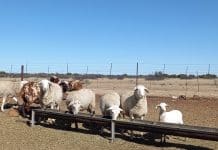In light of the current low maize price, more and more livestock farmers are considering the prospect of rounding off animals for the market themselves. There is merit in the point of view that you should keep control over your product for as long as possible. The more ‘middlemen’ you can eliminate, the more profit you can put in your own pocket.
Lenél Oosthuizen, former manager of a large feedlot group in Harrismith, says the argument may have merit, but rounding off livestock is a specialised field that should not be tackled without thorough preparation and research. The profit margins are simply too small to allow for mistakes.
Lenél highlights several aspects that can determine the success of a feedlot.
Most important aspects
“Feed, water and shelter are probably the most important aspects to take into account,” he says. “with regard to feed troughs, the ideal measurements for a cattle feedlot allow 150mm feeding space per animal. It is important that the troughs drain thoroughly to prevent urea poisoning from the remaining water.
Prepare your animals for the feedlot.
“The troughs need to be at least 150mm above the level that the cattle are standing on, with a floor on which the cattle can stand. It should be designed in such a way that the cattle cannot defecate in the trough or be pushed into it. The floor should be cleaned regularly, and the feed troughs should be eaten clean at least once a day.”
The kraal must be of sturdy construction and no barbed wire may be used. In the case of cattle, between 7 and 10m² of space per animal is optimal. An important aspect to bear in mind is a slope of 15 degrees to enable water to run off. No water may remain in the kraal.
“Kraals must be cleaned regularly to prevent the accumulation of manure. A thick layer of manure increases energy consumption, which in turn affects growth. A 10cm thick layer of mud can cause a loss of 15% in growth.”
Guidelines for water troughs
Water troughs must be washed at least twice a week. There must be a floor in front of each water trough on which the animals can stand when they drink. High-pressure water supply is important, and pipes should not leak and cause wet spots as these spots become a breeding ground for flies, liver fluke and other pests and diseases.
“A handy tip is to throw a handful of salt into the empty trough after it has been washed, and to leave it there for approximately five minutes before it is filled with water. The salt kills parasite eggs and does not affect the taste of the water.”
Cattle drink 40 to 60 litres of water per day, which means that 6 000 litres of water are needed for 100 animals. Always ensure that there is enough water available for at least three days.

Trough management and rations
Lenél says a feedlot is a place where animals are fed, which clearly implies that feed is an essential element – both the feed composition and its presentation. “The correct ration and trough management can have a major effect on the profitability of a feedlot.
“Rations must be of high quality and must meet the nutritional needs of the animals. The balance between fibre and energy should be right, and the feed must be properly mixed and tasty. Rations must be fed in three phases, namely an adaptation phase (nil to 14 days), a growth phase (15 to 90 days) and a rounding off phase (last 30 days).”
Adaptation ration: In the adaptation phase, the energy levels should be lower and the fibre levels higher to prevent damage to the rumen wall. Damage to the rumen wall in this phase has a major influence on the growth of the calf later in the kraal, as the absorption surface of the rumen becomes smaller. Keep in mind that the rumen content is broken down by micro-organisms. Additional roughage in the form of a bale must be provided during the adaptation phase and feed supplements can have a major effect.
Growth ration: In the growth phase, the energy levels are adjusted upward and fibre levels downward. The microbes in the stomach have gotten used to high starch and energy, and additional roughage is not necessary anymore.
Rounding off ration: In the rounding off phase, the energy value increases and the fibre levels decrease. During this phase a beta-agonist (Zilmax) is recommended at the right inclusion level. It must be fed to selected animals for only 30 days. The cattle return to the growth ration for the last five days before being slaughtered. The ration must have enough moisture (so that it is not blown away), be as cheap as possible, be consistent every day and must be regularly tested.
Take feed samples

A feed sample is taken when the feed is put into the trough, by taking three scoops of feed at every meter – one from the top, one in the middle and one at the bottom. The scoops of feed are mixed in a bucket and sealed in a self-sealing bag. Keep it in the fridge until it is sent to the laboratory for analyses.
“Use silage, which is an easy way of increasing moisture and making rations cheaper,” says Lenél. “It requires good management, though, and knowledge of cultivation and the ensiling of grain. High-quality silage must be cut at the right time and properly compacted. It can form up to 30% of the ration.
“Complete fodder flow planning is necessary to balance the need and supply. Cattle ingest approximately 4% of their body weight and the average daily feed intake can be 14kg.”
Take trough readings
Trough management is of utmost importance and requires daily attention. Weigh the feed per kraal, either per bag or per kilogram.
Take a trough reading early in the morning and again at 12:00. The reading ranges from 0 to 5.
0: Licked clean and empty.
1: A floury amount of feed is left.
2: A quarter of the feed is left.
3: Half of the feed is left.
4: No feed has been eaten.
5: The trough is filled to the brim.
Amount of feed
“Based on this reading, the amount of feed needed for the day is determined. Troughs must be eaten clean once a day. It prevents food from becoming rotten and forces cattle to ruminate. Saliva contains buffers that prevent nutritional disturbances.
“Calculate your day from 12:00 to 12:00 the next day. If you weigh feed, 30% of the feed should be fed between 07:00 and 10:00 and 70% between 13:00 and 17:00. The whole allocation can also be given once-off.
“Note the behavioural patterns of the cattle to determine whether your trough management is optimal. If you feed correctly, the trough should be empty by 12:00 and the cattle should be lying down and ruminating,” says Lenél.
For more information, phone Lenél Oosthuizen on 082 851 1089. –Izak Hofmeyr, Stockfarm








